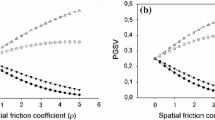Abstract
Given a set of alternatives with multiple attributes, I characterize the set of preference profiles that are representable by weighted versions of a class of utility functions indexed by a parameter δ > 0, where δ ≥ 1 corresponds to the set of Minkowski’s (1886) metric functions. In light of the starkly different consequences between representability with δ ≤ 1 or with δ > 1, I propose a test to empirically estimate δ and I discuss the theoretical and empirical implications for spatial models of political competition.
Similar content being viewed by others
References
Azrieli, Y.: An axiomatic foundation for multidimensional spatial models of elections with a valence dimension. MPRA Working Paper 17614 (2009)
Banks J.S., Duggan J.A.: Dynamic model of democratic elections in multidimensional policy spaces. Q J Polit Sci 3, 269–299 (2008)
Baron, D., Diermeier, D., Fong, P.: A dynamic theory of parliamentary democracy. Econ Theory (2011). doi:10.1007/s00199-011-0625-7
Baron, D., Hirsch, A.V.: Common agency lobbying over coalitions and policy. Econ Theory (2011). doi:10.1007/s00199-011-0628-4
Bianco W.T., Sened I.: Uncovering evidence of conditional party government. Am Polit Sci Rev 99(3), 361–371 (2005)
Blinder A.S.: Distinguished lecture on economics in government: what central bankers could learn From academics. J Econ Persp 11(2), 3–19 (1997)
Bogomolnaia A., Laslier J.-F.: Euclidean preferences. J Math Econ 43, 87–98 (2007)
Candeal-Haro J.C., Induráin-Eraso E.: A note on linear utility. Econ Theory 6(3), 519–522 (1995)
Clinton J.D., Jackman S.D., Rivers D.: The statistical analysis of roll call data: a unified approach. Am Polit Sci Rev 98, 355–370 (2004)
D’Agostino M., Dardanoni V.: What’s so special about Euclidean distance?. Soc Choice Welf 33(2), 211–233 (2009)
Davis O.A., DeGroot M.H., Hinich M.J.: Social preference orderings and majority rule. Econometrica 40(1), 147–157 (1972)
Degan A., Merlo A.: Do voters vote ideologically?. J Econ Theory 144(5), 1868–1894 (2009)
Downs A.: An economic theory of political action in a democracy. J Polit Econ 65(2), 135–150 (1957)
Eguia J.X.: Foundations of spatial preferences. J Math Econ 47(2), 200–205 (2011a)
Eguia, J.X.: A spatial theory of party formation. Econ Theory. (2011b). doi:10.1007/s00199-011-0604-z
Enelow J.M., Hinich M.J.: A new approach to voter uncertainty in the Downsian spatial model. Am J Polit Sci 25(3), 483–493 (1981)
Evren O.: On the existence of expected multi-utility representations. Econ Theory 35(3), 575–592 (2008)
Feddersen T.J.: A voting model implying Duverger’s law and positive turnout. Am J Polit Sci 36(4), 938–962 (1992)
Feeny S.: Policy preferences in fical response studies. J Int Dev 18, 1167–1175 (2006)
Fishburn P.C.: Utility Theory for Decision Making. Wiley, New York (1970)
Gomberg A.M., Francisco M., Ignacio O.-O.: A model of endogenous political party platforms. Econ Theory 24, 373–394 (2004)
Grynaviski J.D., Corrigan B.E.: Specification issues in proximity models of candidate evaluation (with Issue Importance). Polit Anal 14, 393–420 (2006)
Heller P.S.: A model of public Fiscal behavior in developing countries: aid, investment, and taxation. Am Econ Rev 65(3), 429–445 (1975)
Hotelling H.: Stability in competition. Econ J 39(153), 41–57 (1929)
Kalandrakis T.: Regularity of pure strategy equilibrium points in a class of bargaining games. Econ Theory 28, 309–329 (2006)
Kamada, Y., Kojima, F.: Voter Preferences, Polarization and Electoral Policies. working paper, Jan 2010
Kannai Y.: Concavifiability and constructions of concave utility functions. J Math Econ 4(1), 1–56 (1977)
Knoblauch V.: Recognizing one-dimensional Euclidean preference profiles. J Math Econ 46(1), 1–5 (2010)
Kramer G.H.: A dynamical model of political equilibrium. J Econ Theory 16(2), 310–334 (1977)
Krasa S., Polborn M.: Competition between specialized candidates. Am Polit Sci Rev 104(4), 745–765 (2010)
McKelvey R.D.: Intransitivities in multidimensional voting models and some implications for agenda control. J Econ Theory 12, 472–482 (1976)
McKelvey R.D.: General conditions for global intransitivities in formal voting models. Econometrica 47(5), 1085–1112 (1979)
McKelvey R.D., Schofield N.: Generalized symmetry conditions at a core point. Econometrica 55(4), 923–933 (1987)
Minkowski H.: Geometrie der Zahlen. Teubner Verlag, Leipzig (1886)
Plott C.R.: A notion of equilibrium and its possibility under majority rule. Am Econ Rev 57(4), 331–347 (1967)
Poole K., Rosenthal H.: A spatial model for roll call analysis. Am J Polit Sci 29, 331–347 (1985)
Richter M.K., Wong K.-C.: Concave utility on finite sets. J Econ Theory 115(2), 341–357 (2004)
Ruge-Murcia F.J.: Inflation targeting under asymmetric preferences. J Money Credit Bank 35(5), 763–785 (2003)
Schofield N.: Political equilibria with electoral uncertainty. Soc Choice Welf 28, 461–490 (2007)
Schofield N.: The mean voter theorem: necessary and sufficient conditions for convergent equilibrium. Rev Econ Stud 74, 965–980 (2007)
Schofield N., Sened I.: Multiparty Democracy. Cambridge University Press, Cambridge (2006)
Sened I.: A model of coalition formation: theory and evidence. J Polit 58(2), 350–372 (1996)
Surico P.: The Fed’s onetary policy and US inflation: the case of asymmetric preferences. J Econ Dyn Control 31(1), 305–324 (2007)
von Neumann J., Morgenstern O.: Theory of Games and Economic Behavior. Princeton University Press, Princeton (1944)
Westholm A.: Distance versus direction: the illusory defeat of the proximity theory of electoral choice. Am Polit Sci Rev 91(4), 865–883 (1997)
Zakharov, A., Fantazzinni, D.: Idiosyncratic issue salience in probabilistic voting models: The cases of Netherlands, UK, and Israel. Moscow School of Economics Working Paper (2008)
Author information
Authors and Affiliations
Corresponding author
Additional information
I am grateful to Miguel A. Ballester, Christian Hellwig, Navin Kartik and Efe Ok for their inspiring suggestions. I also thank Patrick Le Bihan, Macartan Humphreys, Wolfgang Pesendorfer, and participants at the 2009 Economics and Philosophy Summer School (Donostia), 2009 ESSET (Gerzensee) and seminars at Berkeley, Málaga, Rutgers, Warwick and Wash. U. in St. Louis for their valuable comments. I wrote the current version while visiting the Kellogg School of Management (Northwestern University), and I am grateful for financial support from its Ford Motor Company Center for Global Citizenship and from its Center for Mathematical Studies in Economics and Management Sciences.
Rights and permissions
About this article
Cite this article
Eguia, J.X. On the spatial representation of preference profiles. Econ Theory 52, 103–128 (2013). https://doi.org/10.1007/s00199-011-0669-8
Received:
Accepted:
Published:
Issue Date:
DOI: https://doi.org/10.1007/s00199-011-0669-8




